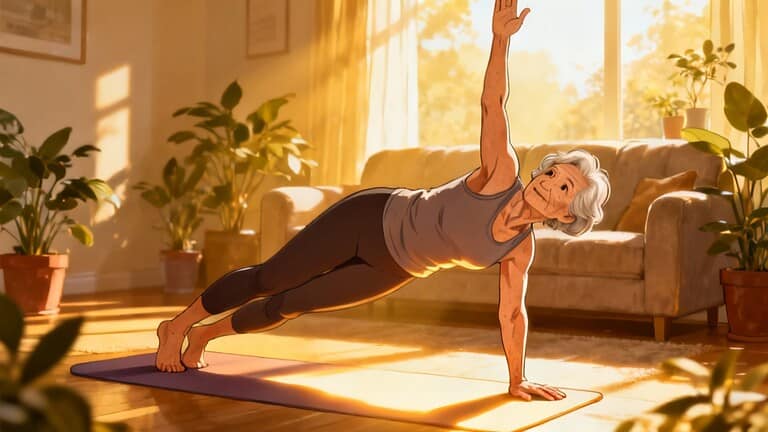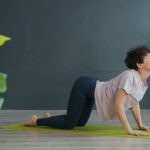Staying strong and independent as you age doesn’t have to be complicated. In fact, some of the most effective exercises for building core strength are isometric moves that you can do at home with no equipment.
If you’re over 60 and looking to improve your balance, reduce back pain, and move with confidence, these five exercises could be a game-changer.
1. Front Plank: Building the Foundation
The front plank strengthens your deep abdominal muscles, lower back, and hips. It’s like laying a solid foundation for everyday movements, from getting out of bed to carrying groceries.
How to Do It
Start by lying face down on the floor. Place your forearms under your shoulders with elbows bent at 90 degrees. Push up onto your toes and forearms, keeping your body in a straight line from head to heels. Tighten your belly and glutes, and hold while breathing steadily.
Safety Tips
Avoid this exercise if you have shoulder injuries, uncontrolled high blood pressure, or severe wrist pain. Consult your doctor if you’ve had recent surgery.
Modifications
- Wall plank: Stand facing a wall, place forearms on it, and lean forward.
- Countertop plank: Use a sturdy counter for support.
- Knee plank: Drop knees to the floor to reduce strain.
Hold for as long as you can, even 10 seconds is a great start. Aim for 30-45 seconds over time.
2. Side Plank: Strength for Stability
The side plank targets your obliques, hips, and shoulders, helping you twist safely and stay balanced during daily activities like reaching or turning.
How to Do It
Lie on your side with legs straight and stacked. Place your bottom elbow under your shoulder. Lift your hips off the ground, creating a straight line from head to feet. Hold, then switch sides.
Safety Tips
Skip this if you have shoulder injuries, severe arthritis, or unsteady balance. Get medical clearance after surgery.
Modifications
- Knee side plank: Bend your bottom knee and keep it on the floor.
- Chair side plank: Use a sturdy chair for support.
- Wall side plank: Stand sideways near a wall and press your forearm against it.
Start with 10-15 seconds per side and gradually increase.
3. V-Hold: Power for Everyday Moves
The V-hold works your upper and lower abs, building strength for tasks like standing up from a chair or climbing stairs without feeling wobbly.
How to Do It
Sit on the floor with knees bent and feet flat. Lean back slightly, lift your feet off the floor, and extend your arms forward. Hold while breathing steadily.
Safety Tips
Avoid if you have lower back injuries, hip pain, or severe osteoporosis. Listen to your body.
Modifications
- Keep heels on the floor and lean back slightly.
- Sit on a chair, lean back, and lift one foot at a time.
Hold for 5-10 seconds to start, and build up over time.
4. Hollow Hold: Training Your Body Shield
The hollow hold strengthens your entire abdominal wall, acting like a shield for your back during lifts, steps, or twists.
How to Do It
Lie flat on your back with arms overhead and legs straight. Press your lower back into the floor, then lift your shoulders and legs a few inches off the ground. Hold while breathing.
Safety Tips
Skip this if you have lower back pain, herniated discs, or recent surgery. Use modifications to avoid strain.
Modifications
- Keep knees bent and feet on the floor, lifting only shoulders.
- Lift only legs or only upper body, not both.
Hold for 5-10 seconds and rest. This exercise teaches your core to support you automatically.
5. Superman: Strengthening the Back That Supports You
The Superman exercise targets muscles along your spine, glutes, and shoulders, helping you stand tall, reduce back pain, and breathe easier.
How to Do It
Lie face down with legs straight and arms extended overhead. Lift your arms, chest, and legs a few inches off the floor. Hold for 2-5 seconds, then lower slowly.
Safety Tips
Avoid if you have spinal fractures, severe osteoporosis, or significant back pain. Try gentler versions first.
Modifications
- Single arm/leg lift: Lift right arm and left leg, then switch.
- Upper body only: Lift just arms and chest.
- Lower body only: Lift just legs.
Start with 5-8 repetitions, holding each lift briefly. This move helps reclaim mobility and independence.
Incorporating these five isometric exercises into your routine can lead to remarkable improvements in core strength, balance, and confidence.
Remember, consistency is key—even 10 minutes a day can make a difference. Start small, listen to your body, and celebrate each progress.
Age is just a number, but strength is a choice that empowers you to live life on your terms.








